A/Sgt Cecil James Fisher, MM (B 46519) (1913–44)
Introduction
I learned of Sgt Fisher when reading Maj Hugh Maclean’s post-war 1945 account of the 1st Battalion (its eight chapters were published in 1953 by a committee of the Regiment with three chapters, essentially of lists, bookending it. I first met Hugh in 1986 and he made an indelible impression. The respect was almost instant (within the space of our five-hour interview) and with it came considerable fondness as well. He was, to my mind, the obvious Argyll to write the foreword to Black yesterdays and, although ill, he did not refuse.
When the fighting subsided in early November 1944, Hugh began the next chapter with a stock-taking of those bloody, tumultuous, and wearying months. The Argylls losses were heavy, and he mentioned but a few of those killed in action by name. Cecil Fisher was one of them, and he became an obvious choice for an Argyll poppy.
I made an effort to locate Sgt Fisher’s family and found his daughter, Maxine, who helped fill in some of the gaps in a heartbreaking family story.
Robert L. Fraser
Regimental Historian
Death in battle is different, Sam Chapman thought:
“He is cut down in an instant with all his future a page now to remain forever blank.
There is an end but no conclusion.”
– Capt Sam Chapman, C and D Coys
“High ability, c[l]ose to superior intelligence and learning capacity”
“High ability, c[l]ose to superior intelligence and learning capacity. This soldier is a mature, steady man whose reliability should make him very useful” – such was the judgement of the Personnel Selection Officer after reviewing Fisher’s file and interviewing him at Camp Niagara in late May 1943. The battalion had just returned from 22 months in Jamaica, and those eligible for overseas service required vetting.
“Broken”
Cecil Fisher was born on 29 December 1913 at Webbwood, Sudbury County, to John Fisher and Sarah Spence. It was a small town in northern Ontario that had opened in the 1880s and was centred on mining. Army records note “racial origin,” and his father’s was given as “Scotland” and his mother’s as “Ireland (North).” John Fisher was a farmer and young Cecil left grade 8 at the age of 12 to work on the farm until 1934. It is a bromide that life in the 1930s was hard, and it is abundantly true for the Fisher family. Cecil’s “weekly wage” on the farm appeared “as required.” Family life was difficult. One of his army forms has a notation about the status of home life in childhood: “Broken – 26 yr old Mother died [she died of cancer]. 24 yr old Father died.” From 1935 to 1940, Fisher worked as a “Converter Skimmer in Smelter Nickel and Copper” at International Nickel in Copper Cliff, earning $40 weekly. On 30 June 1938 he married Edith Cavell Langlade of Britt in Sudbury County. They married in Copper Cliff at the United Church; their son, Russell John, was born on 19 September 1939. Cecil’s hobbies were “running,” mechanics, and “gunsmithing” – he owned several types of guns and “is very interested in his collection.” He also enjoyed hunting and fishing, and played softball (“field”) for the YMCA.
“Patriotic Reasons only”
The outbreak of war in September 1939 changed the course of Fisher’s life. Upon enlistment on 18 December 1940 – he joined, he told the army interviewer, for “Patriotic Reasons only” – both his parents were deceased, and he was living in Little Current and had five months with the Sault Ste. Marie and Sudbury Regiment. The “family farm is still retained,” a personnel officer recorded. Although the farm offered a possibility for his life after discharge, Fisher’s stated preference was the provincial civil service, specifically the Ontario Forestry Branch. At 6’, 164 lb, with blue eyes and fair hair, his health was “good”; his attitude to service “normal”; and next to the form’s field for “Marital Problems” was written “Normal.”
Fisher’s family remained in Little Current while the Argylls trained in the Niagara peninsula; moved to Camp Nanaimo, B.C., from May to August 1941; and then to Jamaica from September 1941 until late May 1943. Fisher had a furlough from 15 to 29 July 1941 and, presumably, returned home. The early years of the war were largely uneventful: Fisher became an acting lance corporal on 21 February 1941 but reverted to private “at own request” on 15 May 1941. His younger brother, David Henry Fisher, enlisted and went overseas (he would commit suicide in 1952). Cecil’s daughter, Maxine Marilyn, was born on 8 April 1942 and there were more promotions: lance corporal on 27 November 1941; acting corporal on 23 June 1942; and corporal on 3 November 1942. By 1943, he was a “section leader” in 12 Platoon, B Coy.
“Conscientious N.C.O. well liked by all members of his present company”
The Argylls returned to Camp Niagara in late May 1943 and then went overseas. Again, Fisher had a furlough to visit his family (28 May to 14 June); it would be the last time they saw each other. Overseas, Fisher attended a weapons training course, and on 16 October 1943 he was promoted acting lance sergeant. Many Argylls were interviewed again in January 1944. The personnel officer remarked on Fisher’s abilities and military preferences. He had other ideas about the future direction of his service: “This soldier has wide experience in Arms-rebuilding, adjusting, loading shells etc. Has strong desire for this type of service. Of high average ‘M’ score, shows high intelligence. Conscientious N.C.O. well liked by all members of his present company.”
For his part, Fisher was unequivocal about his choice: “1) Armourer (R.C.O.C.) 2) Platoon. N.C.O.” The casualty rates of Canadian infantry in Italy demonstrated incontestably the need for infantry. The personnel section officer had the last say as far as “Suggested Possibilities for Employment” and reversed Fisher’s preferences – his destiny was with the infantry and the Argylls. Fisher was promoted lance sergeant on 19 January 1944 now that his military path – infantry NCO – was set.
“bold and courageous leadership”
The Argylls went into action in late July 1944. Fisher saw action with 12 Platoon in the early days of August, when the unit suffered high casualties in the heat and dust of France. For his actions on 5 August in the ill-fated attack on the small fortress of Tilley-la-Campagne, he later received the Military Medal (9 June 1945). The enemy had pinned down another platoon with “withering” fire:
“A second platoon of which Lance-Sergeant Fisher was Platoon Sergeant was ordered to … draw the enemy’s fire … [he] led … with great boldness. At one point he stood on a wall in full view of the enemy, firing a Bren gun from the hip … Although wounded in the head and back, he and his platoon continued to divert the enemy’s fire until the fighting patrol had successfully withdrawn. [Because] of … [his] bold and courageous leadership, which continued after he had been wounded, his platoon created a successful diversion.”
“the most terrifying experience of my life”
On 14 August, the unit promoted Fisher acting sergeant. B Coy had lost its company commander, Maj Don “Pappy” Coons, wounded at Hill 195; he was succeeded by Maj Ivan Martin. B Coy was part of a small battle group desperately trying to close the Falaise Gap (19-21 August 1944). For Pte Sidney Webb, it was “the most terrifying experience of my life.” Maj Martin and 12 Platoon’s, Lt Al Dalpé, were both killed on the 21st. Pte Robert Fraser of 12 recalled:
“…the Germans came out and crossed the field shoulder to shoulder … There was a couple of tanks with us still active. They opened up and we opened up. And it got so bad that Sergeant Fisher said, ‘Every man for himself.’ So we tried to get back to the Regiment. And we found out we were surrounded, because we were around the back of the Germans. [The] Germans saw the equipment and counter-attacked … Some guys were running up the hill, we were cutting them down … There was another guy and myself, we run along the bottom of the hill. And [the Germans] were going over top of us, so we were fortunate … So my Bren gunner and I ran along the bottom. We get about ten yards from the road, and there was a big ditch and he threw the Bren gun in there. Oh, I coulda killed him. So then we get back … big, high walls around — stone walls … six feet high. To get over, you need both hands to get up. So I threw my Bren gun over, jumped up over, and all we could see were Germans. There was one hundred of them in this barnyard. That’s where we kept the prisoners. I almost died.”
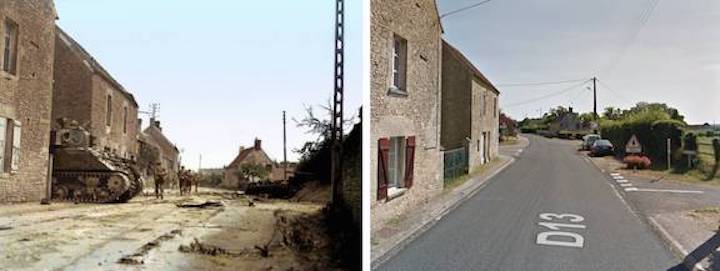 B Coy Argylls at St Lambert with SAR tank (C Sqn), with image at right of road and buildings today.
B Coy Argylls at St Lambert with SAR tank (C Sqn), with image at right of road and buildings today.
“old 12 Platoon could only muster 6 men”
Sgt Fisher was killed here. Pte Harold R. Schaus of 12 Platoon retained a grim memory of the action:
“After St. Lambert old 12 Platoon could only muster 6 men. The whole company only a few over twenty. We lost some fine officers and N.C.O.’S [sic] including Lt. Dalpe, our Platoon Commander.
…Of the six of us that could muster from 12 platoon, there was McAllister, Harris and … I forget the others – it could have been Joe Rowley, Bob Fraser and Joslin. Three of us were escorting about 150 prisoners from the farm where 12 platoon was holding off a bunch of S.S. The farm was about a mile past St. Lambert along a sunken road. The S.A.R.’S [sic] were firing over our heads and the Germans were popping up all along the road either to surrender or take a pot shot at us. We couldn’t get back to the farm and not many of 12 platoon got back to St. Lambert. That’s why.”
The unit’s war diarist, Lt Claude Bissell, wrote on the 21st: the “heavy fighting in St. Lambert ended today” and “the town became the symbol of the utter defeat and annihilation of the German Army.” B and C Coys together had been reduced to “not more than 70 men” and “their own casualties were high, about 30%, but not unusually high, considering that the enemy outnumbered them by 50:1.” None the less, there were casualties.
“All that’s left”
On 22 August, CSM George Mitchell of C Coy wrote in his diary: “stench terrific, death + destruction to Germany.” As for C Coy and his own “gang” of brothers: “All that’s left … is White – and myself.” By the end of the first ten days of September, the old “gang” of the four rifle companies that arrived in France in late July would be almost gone. Of the more than 800 men who had landed, 90 were killed in action, 278 wounded, and 32 POWs for a total of 410 – more than 50% of the unit’s strength and about 80% of its fighting strength. The gallant Sgt Fisher, who had enlisted in December 1940, was among those never to return. Had he become an armourer in January 1944, it might not have happened.
“We never even had a picture”
Sgt Fisher left little in his personal belongings: photos, his glengarry, and his daughter’s birth certificate. His personnel file records that his medals, sent to his wife, were returned undelivered and a notation reads: “Hold until applied for according to HQ this woman deserted her children. 8/12/51.” Edith Fisher, now Edith Prescott, had remarried. Fisher’s daughter Maxine (MacDonald) said that her mother “gave up” her children.” Their great-aunt Lucy Spence (Tallon) raised Russell (1939-2017; served 31 years with the RCEME) and Maxine. Maxine recalls that one day when she was five or six years old, “I called Aunty Lucy ‘Mom’ – she said, ‘You have a mom.’” Years later, Maxine tried to understand what happened, but “Mother wouldn’t talk about it.” In 1983, Russell requested his father’s medals and received them; he had, his sister explained, “disowned” their mother. As for Maxine, her brother told her that “Dad was tall with red hair” – all she knew. “We never even had a picture,” she recalled tearfully. His “medals [were our] only connection.”
“None would forget … Sgt Fisher of ‘B’ ”
Maj Hugh Maclean wrote in his 1946 history of the battalion: “None would forget … Sgt Fisher of ‘B.’”
Between 10 and 15 August 1944, 13 Argylls were killed in action and 36 wounded.
“a history bought by blood” – Capt Sam Chapman, C and D Coys
Robert L. Fraser
Regimental Historian
With respect, in memory of Maj Rob Fead – Col Rick D. Kennedy, CD
Note: Sgt Fisher’s poppy is located in the Argyll Field of Remembrance in the middle cluster; bottom grouping, at about 1300.
 Webbwood, Ontario, circa 1913.
Webbwood, Ontario, circa 1913.
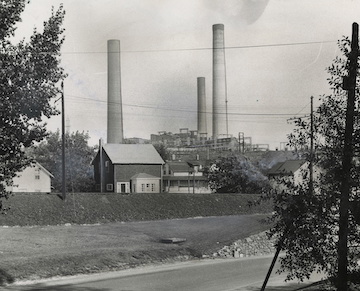 INCO’s Copper Cliff smelter.
INCO’s Copper Cliff smelter.
 Copper Cliff United Church.
Copper Cliff United Church.
 An Argyll on the left, St-Lambert.
An Argyll on the left, St-Lambert.
 Road at St-Lambert.
Road at St-Lambert.
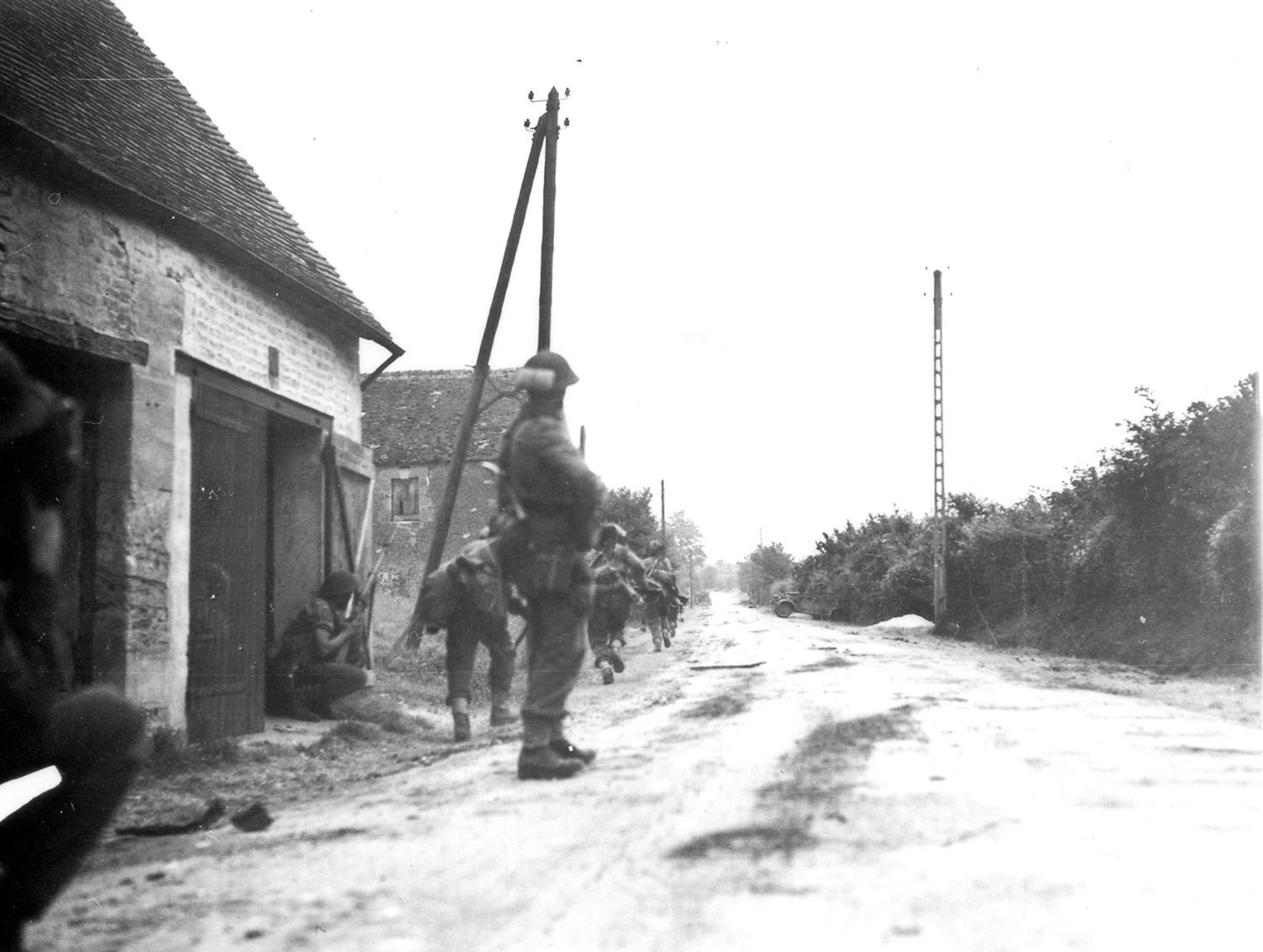 B Coy Argylls at St-Lambert.
B Coy Argylls at St-Lambert.
 St-Lambert: SAR tank with B Coy Argylls.
St-Lambert: SAR tank with B Coy Argylls.
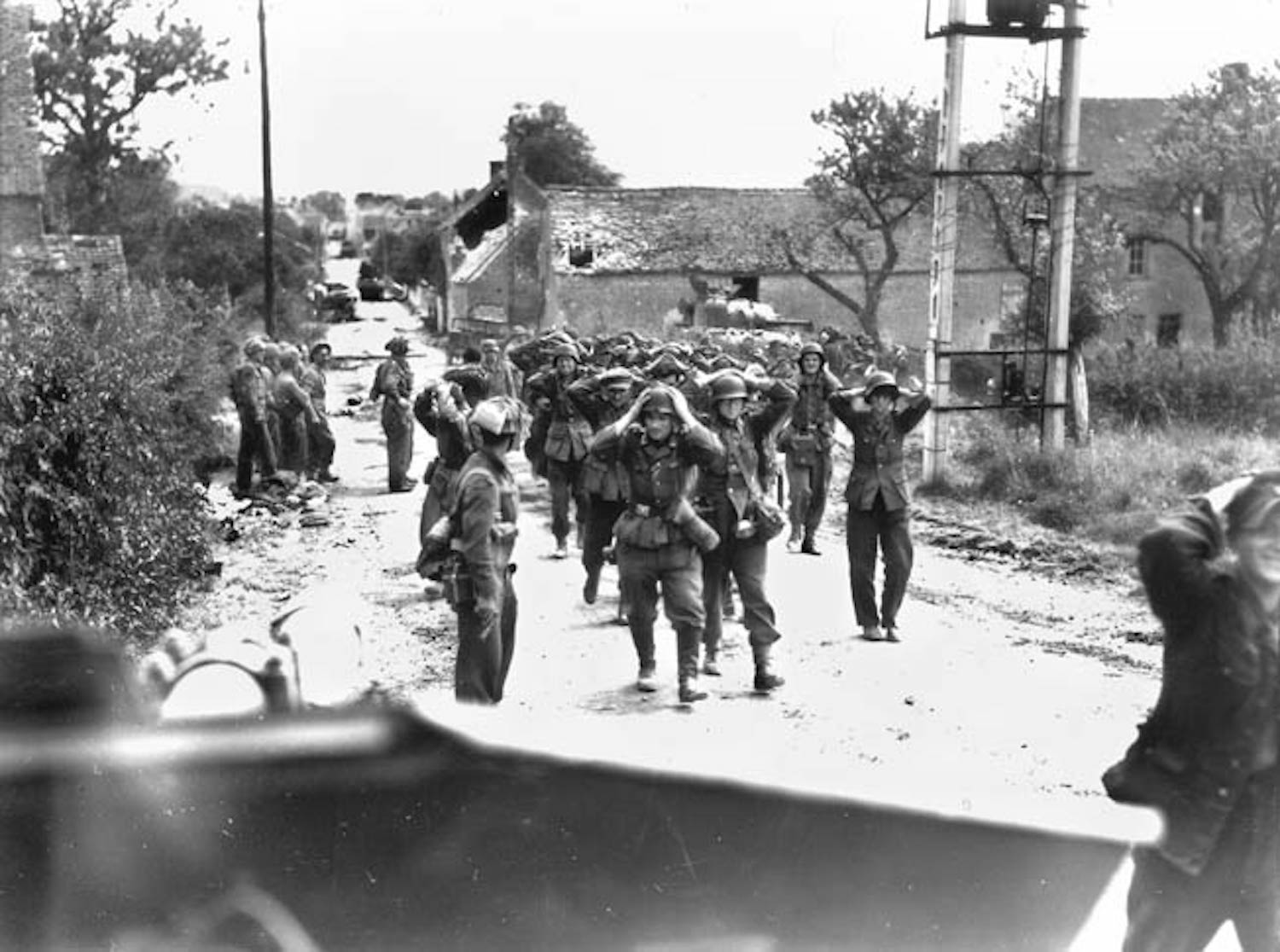 Surrender at St-Lambert.
Surrender at St-Lambert.
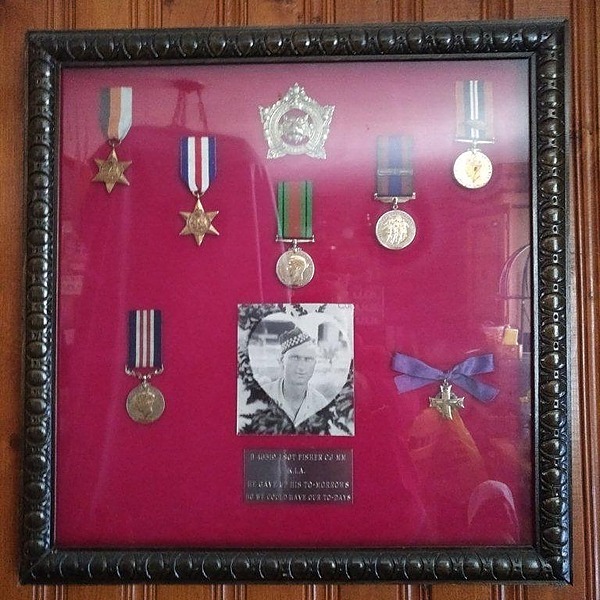 Sgt Fisher’s medals.
Sgt Fisher’s medals.
